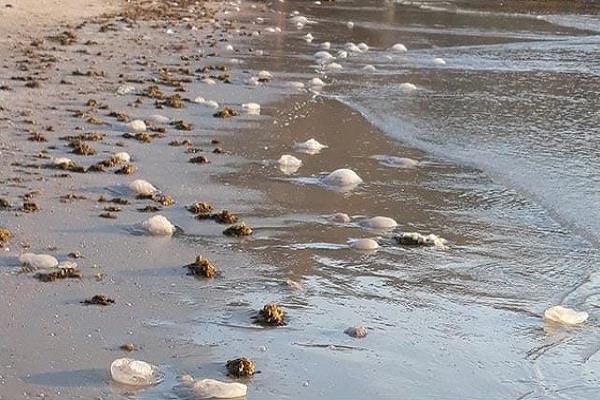A power station in southern Israel has been dealing with a wave of thousands of jellyfish that could affect its output.
The jellyfish have been piling up at the Ashkelon station’s filters, which are designed to prevent them from reaching operating systems and to divert them to dedicated tanks.
בתחנת הכוח רוטנברג עדיין נלחמים בכמויות של מדוזות שמגיעות למסננים של מי הקרור. משתמשים במי הים לקרור הקיטור לאחר פעולתו בטורבינות. אם המסננים ייסתמו יש חשש להפסקת יחידות ייצור החשמל צמודות החופים.
— ינון עידן (@yinon_idan) July 6, 2019
קרדיט לצילומים ולסירטונים תמיר זק . pic.twitter.com/bKAhay4EWt
The IEC’s coastal plants use seawater to cool its systems. Jellyfish have also caused problems for desalination plants in Israel as well. In 2011, jellyfish obstructing filters forced a nuclear reactor in Scotland to shut down temporarily.
In this video, you see the nomad jellyfish pouring into the Rutenberg power station at Ashkelon:
Seasonal nomad jellyfish invasion
Israel’s yearly jellyfish season is well and truly here, disturbing local beachgoers and tourists alike. The swarm consisting of tens of millions of jellyfish has reached the Ashkelon and Ashdod areas this week, and is expected to move on to the beaches of central and northern Israel.

Are we seeing increasing rates of jellyfish coming to Israel’s coast?
These swarms have been happening in our region since the 1980s and in varying abundances, so until we carry out large-scale quantitative assessments (rather than impressions), the jury is out on whether there is an increase or not.
This year specifically is anomalous because the recent winter had exceptionally high rainfall that washed out large quantities of nutrients to our normally nutrient-poor sea, driving production rates up and providing lots of food to all members of the marine food web, including the jellyfish. The swarms recur in this region year after year because the jellyfish have become established here.
What threats come up with those swarms?
The impacts of jellyfish to the ecosystem are numerous and not necessarily all negative:
- The jellyfish compete directly and quite efficiently with larval and young finfish over planktonic food, and in some cases, the jellies have caused these fish populations to “starve.”
- Jellyfish are predators, and massive swarms/blooms with large predation pressure can cause ecosystems to become unbalanced.
- Jellyfish blooms mean considerable biomass in the water column, and when that material sinks and decomposes on the seafloor, it can either cause the formation of hypoxic and anoxic sediments (dead zones) or a feast to bottom dwellers (benthos) that enjoy the food (like manna in the sea).
- Jellyfish blooms can cause mechanical clogging of coastal power plants that use seawater to cool their turbines, problems to desalination plants that use seawater to generate freshwater, problems to fisherfolk that want to target finfish or other marine species, all marine recreation and aquaculture farms that grow fish in cages.
It's #jellyfish season in #Israel, so beach goers beware! @EricaJnews reports from the beaches of @TelAviv: pic.twitter.com/gcMcLA16xB
— i24NEWS English (@i24NEWS_EN) 11. Juli 2019
Can we avoid jellyfish invasions in the future?
We cannot avoid swarms, as these are natural phenomena, but we need to do more research to understand the dynamics of the swarms better in order to eventually be able to predict these.
ים מדוזות pic.twitter.com/zlfzfY1ArI
— ינון עידן (@yinon_idan) July 9, 2019
Common knowledge assumes there is ongoing competition between larval (and young) finfish and jellyfish because they all rely on the same planktonic organisms for food. Overfishing or heavy fishing pressure often results in reduced finfish populations, which may give the upper hand to their competitors, the jellyfish. So if we maintain healthier populations of finfish, this may reduce jellyfish swarms.
We are being invaded by Aliens????#dontbejelly #jellyfish #israel pic.twitter.com/4mlfVoLIwg
— Amy's Baking Co (@bouzagloabc) July 8, 2019
The same argument is applied to coastal development. Many finfish have natural nurseries near the shore, and if coastal development encroaches on these, this adds pressure to natural fish populations and threatens their survival. A solution to this is to establish marine-protected areas where coastal development does not happen to protect natural biota; this may also ultimately reduce jellyfish swarms.
Jellyfish also seem to be less affected by pollution than other marine groups. So if the sea is polluted by chemicals or other agents, the jellyfish may fare better than other groups – once again boosting their populations and success in comparison to their competition.
The solution to reduce jellyfish invasions, of course, is to reduce marine pollution.












